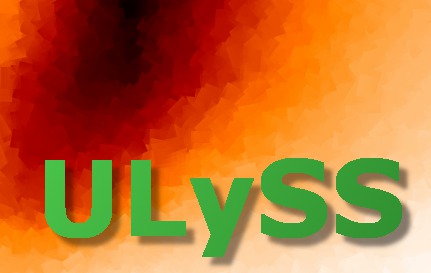
|

|
| Model file | Code | Library | IMF(1) | SFH(2) | λλ / Resolution | Notes |
|---|---|---|---|---|---|---|
| PHR_SB_e31_Salp.fits | PegaseHR | Elodie.3.1 | Salpeter
Mass: 0.1 to 120 M☉ Slope: -1.35 |
SSP | 3900-6800Å
R = 10000 |
Isochrones: Padova 1994
Age range: 1 to 20000 Myr Metallicity range: -2.3 to +0.69 dex. |
| PHR_SB_e31_Krou.fits | PegaseHR | Elodie.3.1 | Kroupa
Mass: 0.1 to 0.5 M☉ Slope: -0.3 Mass: 0.5 to 1 M☉ Slope: -1.2 Mass: 1 to 120 M☉ Slope: -1.7 |
SSP | 3900-6800Å
R = 10000 |
Isochrones: Padova 1994
Age range: 1 to 20000 Myr Metallicity range: -2.3 to +0.69 dex. |
| PHR_SB_e31_Toph.fits | PegaseHR | Elodie.3.1 | Topheavy
Mass: 0.1 to 120 M☉ Slope: -0.8 |
SSP | 3900-6800Å
R = 10000 |
Isochrones: Padova 1994
Age range: 1 to 20000 Myr Metallicity range: -2.3 to +0.69 dex. |
| PHR_Const_e31_Salp.fits | PegaseHR | Elodie.3.1 | Salpeter
Mass: 0.1 to 120 M☉ Slope: -1.35 |
cst | 3900-6800Å
R = 10000 |
Isochrones: Padova 1994
Age range: 1 to 20000 Myr Metallicity range: -2.3 to +0.69 dex. |
| PHR_SB_lcb_Salp.fits | PegaseHR | LCB | Salpeter
Mass: 0.1 to 120 M☉ Slope: -1.35 |
SSP | 100-20000Å
(low resolution) |
Isochrones: Padova 1994
Age range: 1 to 20000 Myr Metallicity range: -2.3 to +0.69 dex. |
| PHR_SB_lcb_Krou.fits | PegaseHR | LCB | Kroupa
Mass: 0.1 to 0.5 M☉ Slope: -0.3 Mass: 0.5 to 1 M☉ Slope: -1.2 Mass: 1 to 120 M☉ Slope: -1.7 |
SSP | 100-20000Å
(low resolution) |
Isochrones: Padova 1994
Age range: 1 to 20000 Myr Metallicity range: -2.3 to +0.69 dex. |
| PHR_SB_lcb_Toph.fits | PegaseHR | LCB | Top heavy
Mass: 0.1 to 120 M☉ Slope: -0.8 |
SSP | 100-20000Å
(low resolution) |
Isochrones: Padova 1994
Age range: 1 to 20000 Myr Metallicity range: -2.3 to +0.69 dex. |
| PHR_Const_lcb_Salp.fits | PegaseHR | LCB | Salpeter
Mass: 0.1 to 120 M☉ Slope: -1.35 |
cst | 100-20000Å
(low resolution) |
Isochrones: Padova 1994
Age range: 1 to 20000 Myr Metallicity range: -2.3 to +0.69 dex. |
Vaz_SB_mil_un13.fits.gz | Vazdekis v9.0 | Miles | Salpeter
Mass: 0.1 to 100 M☉ Slope: -1.35 |
SSP | 3540.5-7409.6Å
R = 2000 |
Isochrones: Padova 2000 (Gerardi et al 2000)
Age range: 63 to 17780 Myr Metallicity range: -2.3 to +0.2 dex. |
| Vaz_SB_mil_kb13.fits.gz | Vazdekis v9.0 | Miles | Kroupa 2001 binaries corrected
Mass: 0.1 to 0.5 M☉ Slope: -0.3 Mass: 0.5 to 100 M☉ Slope: -1.3 |
SSP | 3540.5-7409.6Å
R = 2000 |
Isochrones: Padova 2000 (Gerardi et al 2000)
Age range: 63 to 17780 Myr Metallicity range: -2.3 to +0.2 dex. |
| GAL_SB_ste_Chab.fits | GalexEv | SteLib | Chabrier
Mass: 0.1 to 1 M☉ Slope: exp[-(log m - log 0.08 M☉ )2 / 0.9522 ] Mass: 1 to 100 M☉ Slope: -1.35 |
SSP | 3200-9500Å
R = 2000 |
Isochrones: Padova 1994 (Bertelli et al. 1994).
The metallicity range is [-2.3, 0.4] dex. |
| SB99_Padova_Salpeter.fits | Starburst99 | Martins | Salpeter
Mass: 0.1 to 120 M☉ Slope: -1.35 |
SSP | 3000-6997Å
R = 10000 |
The isochrones are Padova.
Metallicity range: -1.0 to 0.3 dex |
| SB99_Geneva_Salpeter.fits | Starburst99 | Martins | Salpeter
Mass: 0.1 to 120 M☉ Slope: -1.35 |
SSP | 3000-6997Å
R = 10000 |
The isochrones are Geneva. | GD05_Geneva.fits | sed@ | Martins | Salpeter
Mass: 0.1 to 120 M☉ Slope: -1.35 |
SSP | 3000-7000Å
R = 10000 |
The isochrones are Geneva. |
Notes:
(1) The initial mass function, IMF, is described by a set of power-law segments
in some mass ranges. In the simplest case, like the Salpeter's IMF, it is
a single power-law between two limiting mases. The Kroupa's IMF has three
slopes.
In the table above, we indicate the mass ranges and the slope in each range.
The IMF is the distribution function of the formed stars as the function of
their mass, it is parameterized as:
(2) SFH (star formation history), describe the time dependency of the star formation rate. SSP (single stellar population), is an instantaneous burst of star formation. cst is a constant star formation rate.
The 'age' is the time since the star formation started and that the mass of stars which has been formed is proportional to the time, to reach one M☉ after 20 Gyr.
| Model file | Library | λλ / Resolution | Source | Notes |
|---|---|---|---|---|
| miles_tgm.fits alternatively from Vizier |
MILES | 3536-7410Å R = 2000 |
Prugniel, Ph., Vauglin, I., Koleva, M., 2011, A&A, 531, A165 | First version |
| miles_tgm2.fits | MILES | 3536-7410Å R = 2000 |
Sharma, K., Prugniel, Ph., Singh, H.P. | Improved version, requires ULySS v1.3 or higher |
The first SSP models with alpha enhancements build with PEGASE.HR and the ELODIE, CFLIB and MILES libraries, are presented in Prugniel and Koleva, 2011, IAUS 284.
These models are not yet described in details, and they need additional testing... We encourage you to contact us (we may also give fresher versions, or other models). The corresponding SSP components are below (all are not yet posted and will be added in the coming weeks. We will update them).
| Contact: ulyss at obs.univ-lyon1.fr |
Last modified: Tuesday, 04-Dec-2012 18:49:50 CET. |